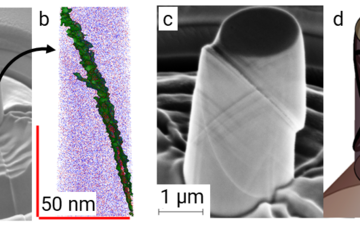All genres
121.
Talk
Which Properties Must a Surface have to be Suitable for Cold Pressure Welding? 22nd International Conference on Material Forming (ESAFORM 2019), Mondragon Unibrtsitatae, Spain (2019)
122.
Talk
Designing smart interfaces based on electro-responsive self-assembled monolayers from coiled-coil peptides. Bunsentagung 2019 - 118th General Assembly of the German Bunsen Society for Physical Chemistry, Jena, Germany (2019)
123.
Talk
Electron transfer of gold modified by self-assembled monolayers in aqueous electrolytes. EMRS fall meeting - european materials research society, Warsaw, Poland (2017)
124.
Talk
Time-dependent Water Uptake in s Polymer Model Coating Visualised by FTIR Microscopy Using a Focal Plane Array Detector. Fourier Transform Spectroscopy 2016, Leipzig, Germany (2016)
125.
Talk
Surface Modification of Iron With Grafted Hydrophobic Acrylic Polymers and Study of Their Delamination Kinetics. Polymers and Organic Chemistry POC16, Hersonissos (Crete), Greece (2016)
126.
Talk
Neue Ergebnisse zur Bildung und Wirkung klassischer und moderner Vorbehandlungen. Gfkorr Jahrestagung, Frankfurt am Main, Germany (2015)
127.
Talk
Chemie der kathodischen Delamination – welche Bindung bricht? Sitzung des Gfkorr Arbeitskreises “Korrosionsschutz durch Beschichtungen”, Frankfurt am Main, Germany (2015)
128.
Talk
Corrosion of aluminum-steel joints produced by cold bulk metal forming process. EUROCORR 2015, Graz, Austria (2015)
129.
Talk
Effect of surface condition on the bond strength between aluminum and steel joint in cold welding. CETAS 2015, Düsseldorf, Germany (2015)
130.
Talk
The Mechanism of Electrochemical Oxygen Reduction: A Combined DFT and in-Situ ATR-IR Study on Model Semiconductor Surfaces Ge(100) and ZnO. 227th ECS Meeting, Chicago, IL, USA (2015)
131.
Talk
A joint first principles and ATR-IR study of the vibrational properties of interfacial water at Si(100):H-H2O solid-liquid interfaces. APS March Meeting 2015 , San Antonio, TX, USA (2015)
132.
Talk
“Green” encapsulation of corrosion inhibitors for smart coatings. EUROCORR 2014, Pisa, Italy (2014)
133.
Talk
Outer membrane associated redox active components in lithotrophic SRB trigger direct electron transfer during anaerobic electrical MIC. Eurocorr 2014, Pisa, Italy (2014)
134.
Talk
Sour corrosion – Investigation of iron sulfide layer growth in saturated H2S solutions. European Corrosion Congress EUROCORR 2014, Pisa, Italy (2014)
135.
Talk
Nanoscale understanding of bond formation during cold welding of aluminum and steel. 6th International Conference on Tribology in Manufacturing Processes & Joining by Plastic Deformation, Darmstadt, Germany (2014)
136.
Talk
Cyclodextrins for corrosion protection. Gordon Research Conference-Aqueous Corrosion, New London, NH, USA (2014)
137.
Talk
Cyclodextrins for corrosion protection. Gordon Research Seminar-Aqueous Corrosion, New London, NH, USA (2014)
138.
Talk
Direct electron uptake by sulfate-reducing bacteria in microbial corrosion of iron. Gordon Research Seminar, Corrosion - Aqueous, New London, NH, USA (2014)
139.
Talk
Controlled release of inhibitors from composite organic coatings: A “green” way of corrosion protection. EUROCORR 2013, Estoril, Portugal (2013)
140.
Talk
Zirconium oxide based conversion layers on aluminum alloys: Role of intermetallics. 112th Bunsentagung (Annual German Conference on Physical Chemistry), Karlsruhe Institute of Technology (KIT), Karlsruhe, Germany (2013)











